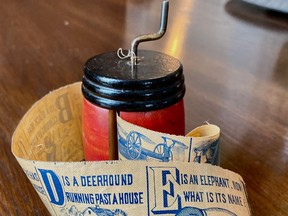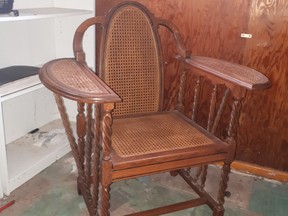
Reviews and recommendations are unbiased and products are independently selected. Postmedia may earn an affiliate commission from purchases made through links on this page.
Article content
Q This is an interesting educational toy – an alphabet in a barrel that has been in our family for several generations. Judging by the illustrations for each letter of the alphabet I think it could date back to my grandmother’s generation to the 1880s or even earlier. The last of her siblings was born in 1883. It’s charming – attractively illustrating a bygone age. I remember playing with it as a child. It’s in good shape, 7.6 cm high (three inches) and the crank allows one to rewind it into the barrel. It’s priceless and we wonder if you know anything about its manufacture. Thanks for any help.
Advertisement 2
Article content
Harold, Kitchener
A Your barrel was made by Foley & Williams. Manufacturing Co., of Chicago, Ill. It was advertised by an agent in 1886 – Geo. M. Smith & Co. of Boston, Mass. – as ‘The Alphabetical Toy Panorama.’ Foley & Williams began with sewing machine production but quickly branched out into pianos and other products as the company success rapidly expanded. Promos included ‘New Educational Toy. Every boy and girl wants it at sight! Twenty-six Object Lessons.’ Another ad from 1888 in The American Stationer mentions the barrel price of 25 cents with a linen (ribbon) 58 inches long (147 cm). My learning curve found this to be a rare and desirable object with sales and asking prices of $550.

Q I am curious about this chair I have. I had the seat and back re-caned recently. It has dowel and cane construction. It was bought in an outdoor antique sale in Pakenham, Ont., many years ago. The appearance is striking. Do you have any idea of its origin or age? I look forward to hearing from you. Many thanks,
Advertisement 3
Article content
John, Old Ottawa East
A Your unusual armchair will inspire the sitter to write whether they are left or right-handed. Most writing chairs of this type have the wide arm only on the right side. There are many high-quality features that have been implemented in this chair. The inlaid highlights of the writing surfaces border the cane and the front apron. The ‘twist’ turnings, more difficult to produce, are striking and the aptly-reinforced structure is impressive. It is oak and dates to about 1890. It could have been made by one of the many serious furniture enterprises of southwestern Ontario. It would be very difficult to find another and will command a lot of attention, making for a value of $350.

Q This oil painting was gifted to my grandfather during the 1920s in Montreal. The canvas measures 23 x 36 cm (14 x 9 inches) and is signed ‘G.H. Hughes.’ I believe the artist is of Irish descent and lived in Montreal in the late 1800s. The painting is in terrible condition – dirty, crazed and has a small hole in the canvas. I’m wondering if it can be restored and if it is worth the cost to have it done professionally. Therefore, I’d be interested to know the difference between an appraisal of the painting ‘as is’ and ‘as restored.’ Thank you.
Advertisement 4
Article content
Diana, Ottawa,
A Your research is sound. George Hart Hughes (1832-1921) was born in Ireland. He immigrated to Canada in 1869 and spent most of his time in Quebec as a painter, architect and engineer and was noted as a bridge designer. Being strongly influenced by Cornelius Krieghoff, he favoured painting Indigenous canoeists, hunters and moccasin sellers. He died in Montreal. Anything can be restored at a cost and the craquelure can be stabilized. The hole with some flaked paint is in a simple part of the background making restoration easier. I think it wise to only assess this painting as it stands. A buyer will incur restoration costs to preserve this scarce example of Canadian history. It is worth $550 today.
John Sewell is an antiques and fine art appraiser. To submit
an item to his column, go to the ‘Contact John’ page at www.johnsewellantiques.ca. Please measure your piece, say when and how you got it, what you paid and list any identifying marks. A high-resolution jpeg photo must also be included. (Only email submissions accepted.)
* Appraisal values are estimates only.*

